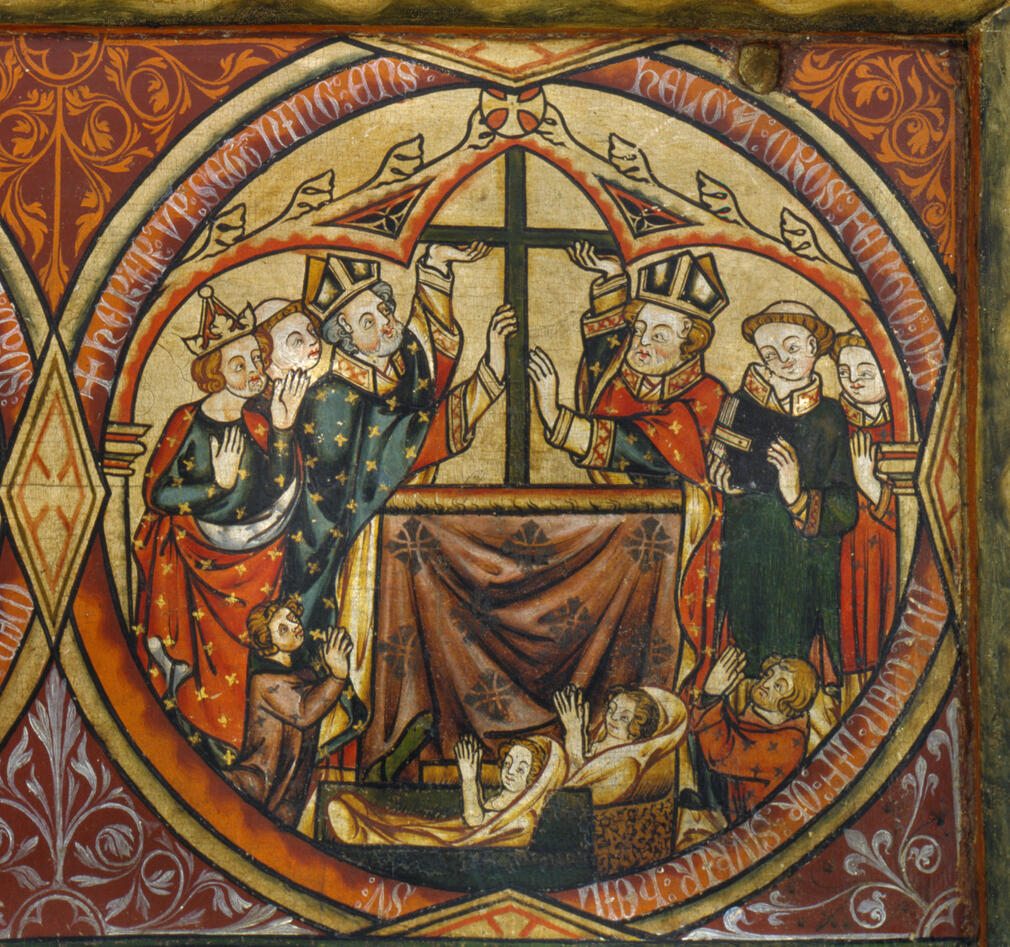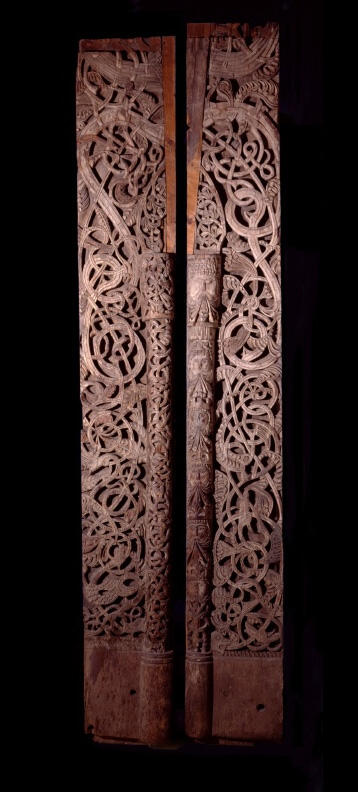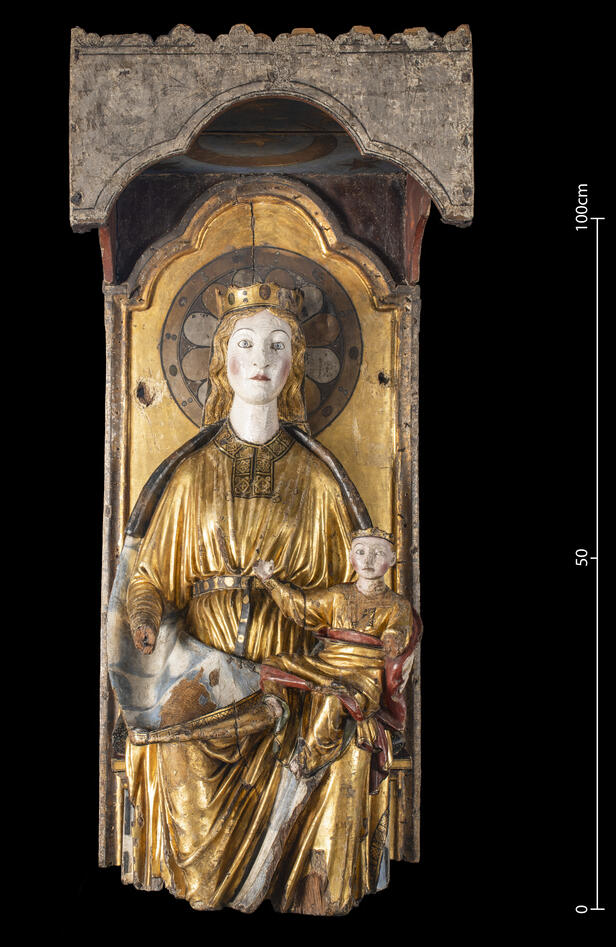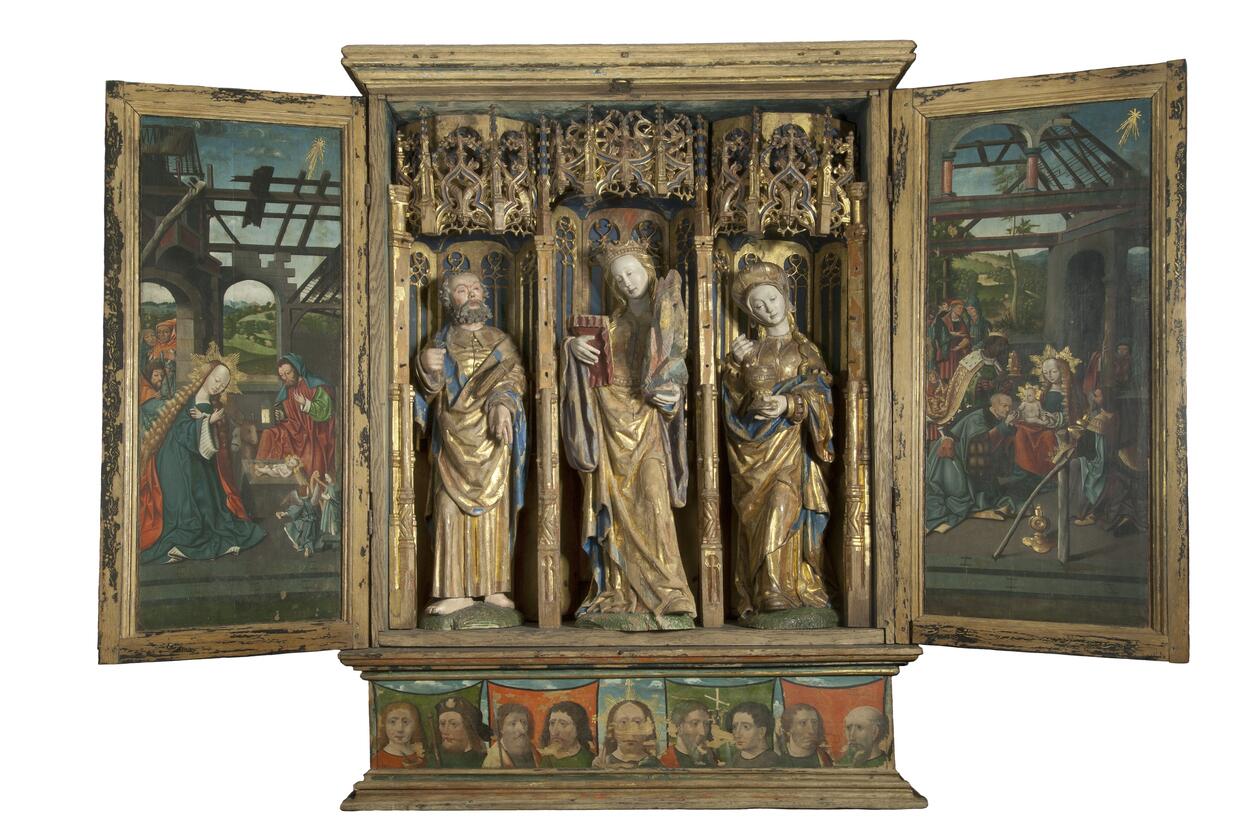"Glows in the dark" – unique European cultural monuments
Imagine entering a western Norwegian village church on a rainy and autumnal Sunday in the 14th century. Only the glow of wax candles gives the room character, and far ahead at the altar in the choir, you are dazzled by a golden, almost supernatural, light that is reflected from an open altarpiece. The mood invites reverence as well as wonder at the mysteries of life.

Main content
By Knut Olav Aslaksen
You can experience a bit of the same atmosphere and reverence during a visit to the Church Art Exhibition at the University Museum in Bergen. The strong visual impressions and the intimate, almost tactile, atmosphere invite reverence and wonder at the medieval idiom and artistic skills.
We ask Professor Justin Kroesen, who is responsible for the collection, what is special about the many objects?
In a European context, the University Museum possesses a truly exeptional collection of church art in wood from the Middle Ages. Most of the objects came to the museum from rural churches in Western Norway in the early 19th century, but they reflect types, styles, techniques and iconographies that link Western Norway to other areas around the North Sea such as Great Britain, the Netherlands and Germany. In fact, also to more distant regions such as France, the Mediterranean area and even the Middle East. In the rest of Europe, much of the church inventory from this period is now lost, both because of war and revolutions, but also because of the Reformation and the Catholic Counter-Reformation, with their new demands for liturgy and church decoration.
How did the art end up in a museum?
When sked to explain how so many works of art from the Middle Ages have been preserved and ended up in the University Museum, we have to take the Lutheran Reformation in 1536–1537 into account. In many Norwegian churches, especially in the isolated mountain and fjord regions of Western Norway, most of the medieval interior was retained, at least at the beginning of the Lutheran era. The equipment was either still in use, got new functions, or was simply "forgotten". The Lutheran tolerance towards Catholic objects and images, together with the absence of large-scale warfare and to some extent also persistent poverty, were among the main reasons why many of the cultural treasures that are now in the church art collection in Bergen did not disappear. This contrasts with many other parts of Europe, where they were either removed, destroyed or replaced. Keen museum founders such as Wilhelm Frimann Koren Christie and Bishop Jacob Neumann saw the importance of taking care of the traces of "the Catholic cultus" as important and visible links to the past. It was thanks to Bergens Museum, which was established in 1825, that the objects were preserved through the dangers of the nineteenth century. This contrasts with Spain, for example, where church art from the Middle Ages became merchandise and was exported to the USA.
What function did the objects have in the Middle Ages?
Most of the objects in the church art collection originally formed a background to the medieval Catholic liturgy. Together, they therefore provide a unique insight into what the interior of village churches looked like in the Middle Ages, not only in Norway but also in other countries. The inventories usually developed in two phases - a first more or less at the same time as the church building in Romanesque and early Gothic styles in the 12th-14th centuries, and a second phase in the late Gothic style in the 15th century.
Was the church art made in Western Norway?
Many of the items probably originated in “craft” workshops in England or on the Continent, while others were made locally in workshops at the church centers in Bjørgvin (Bergen) or in Nidaros (Trondheim). The collection also consists of richly carved church portals and doorjambs from demolished stave churches, which reveal a mixture of Christian and pre-Christian motifs, and which were made on the spot. These are distinctive Norwegian contributions to European church art.
Can you name any highlights of the collection?
The church art collection is particularly rich in early medieval wooden altar decorations. As many as 19 of a total number of around 140 painted altar frontals from the 13th and early 14th centuries that have been preserved in Europe are kept at the University Museum in Bergen. In addition, there are several excellent sculptures of Virgin and Child
including some that have preserved almost all their original colour splendor, polychromy, such as the Virgin and Child from Hove church in Vik in Sogn. Some of these carvings are set in so-called "tabernacle schrines" with movable doors, and bear witness to great woodcarving skills and skills in polychromy.
Another highlight is the painted canopy from Årdal stave church in Sogn, dated to the early 14th century. The collection also includes several small, ornamented reliquaries covered with precious metals, as well as liturgical objects such as aquamaniles, censers, crosses and baptismal fonts. Together, the artworks from the High Middle Ages testify to Norway's cultural flourishing up to the 14th century and the close connections that existed with other countries, especially around the North Sea.
In 1349–1350, Norway was severely affected by the Black Death with subsequent plague epidemics and the country did not recover until the second half of the 15th century. The Late Gothic part of the church art collection in Bergen includes a range of church furnishings from the 15th and early 16th centuries. Most notable here are several altarpieces, but this section of the collection also includes saints’ caskets, altarpieces, liturgical vestments and vessels, a triumphal crucifix, and other sculptures. Styles and techniques reveal that many of these objects have their origins in various parts of the "Hanseatic world", of which Bergen was a part, and which mainly included northern Germany and the northern Netherlands.
The magnificent altarpiece from Austevoll was probably made in Utrecht or Amsterdam, where such objects did not survive the Calvinist Reformation. This was an important reason why I moved to Bergen, to be able to work with such art treasures, says Kroesen, who originally comes from the Netherlands.
How would you describe the significance of the collection for our time?
The importance of the church art collection by far exceeds the relevance of a study collection for teaching and research, or as storytelling objects for a museum in Western Norway. Our church art collection is of great international and European importance. It stems from a country which geographically lay on the outskirts of Europe, but which was nevertheless an integral part of, and closely intertwined with, continental Europe's religious and cultural development in the Middle Ages. The church art collection at the University Museum in Bergen is unique and important, both because it is so well preserved, but also because it represents European art that has a message for the entire continent, concludes Kroesen.
A digital exhibition has therefore been created which you can see in the link https://churchart.w.uib.no
The exhibition is currently closed to the public. Read more about it here.



